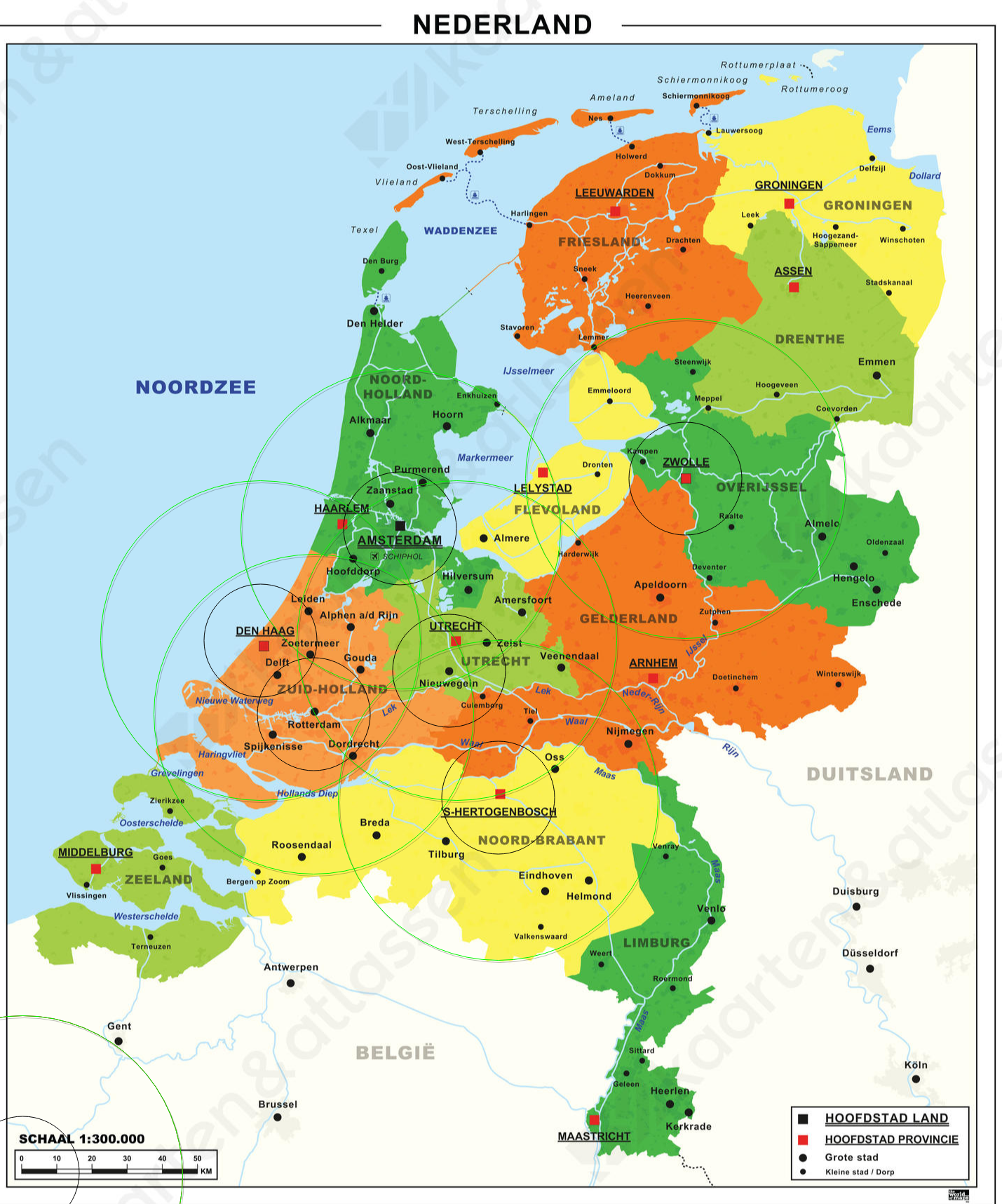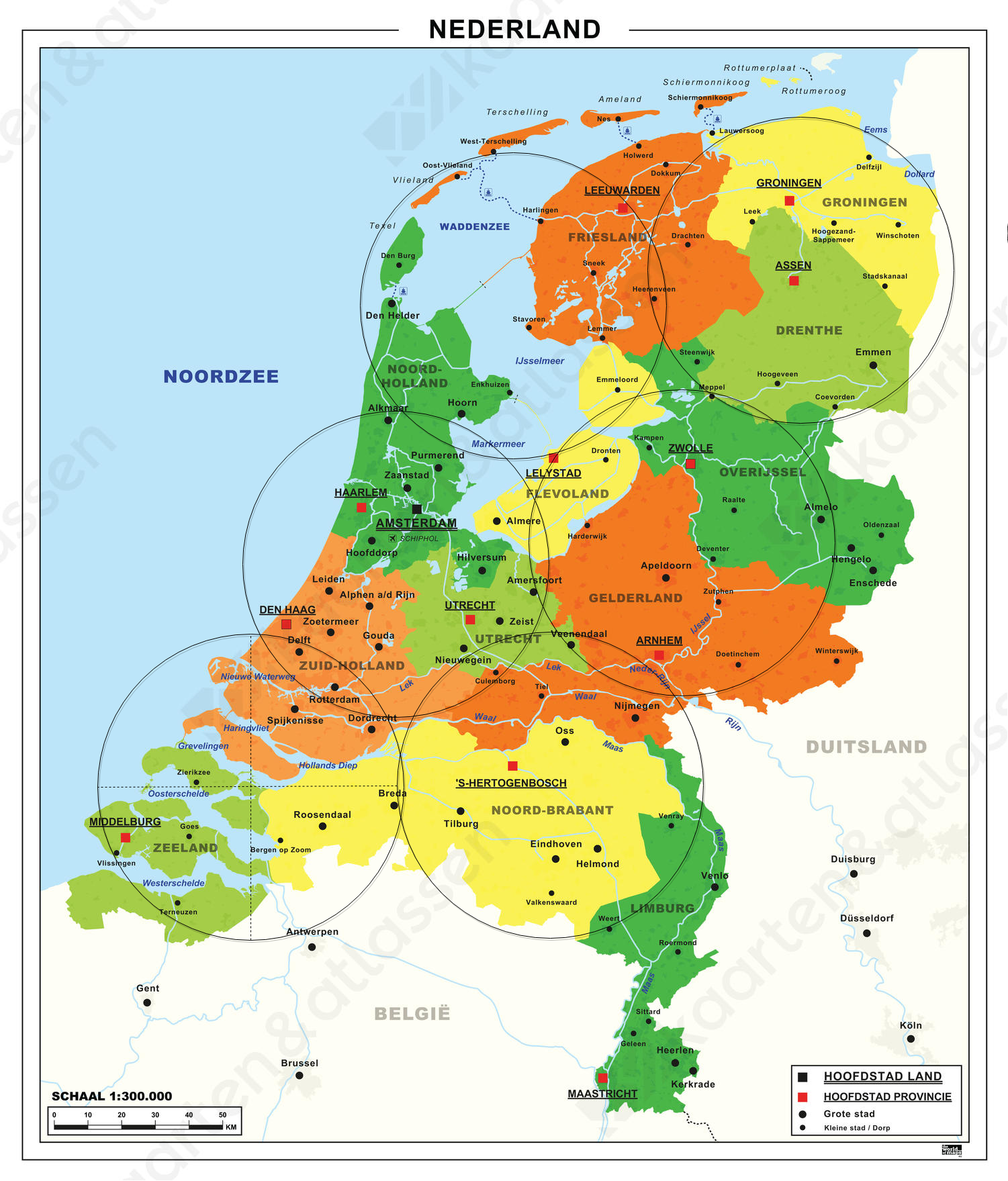PRE2017 3 Groep10: Difference between revisions
| Line 118: | Line 118: | ||
{| class="wikitable" | {| class="wikitable" | ||
! | |||
! Truck | ! Truck | ||
! Drone | ! Drone | ||
Revision as of 12:47, 19 March 2018
Introduction
Online shopping is becoming increaslingly popular [1], this means that parcel delivery is becoming more and more important in daily life. Nowadays parcels are delivered one by one by people, however, with drones becoming more sophisticated, drones might be able to improve this process. This can be done in several ways, one of these ways is by using warehouses which house drones, these drones then do the parcel delivery directly from the warehouse to the buyer. Another method is to drive a truck to a certain location, from where the drones will deliver the parcels to the buyer. Yet another way is to have a 'flying warehouse', for instance a zeppelin, hang in the air, from where the drones can deliver parcels to the buyer.
All these methods have their own advantages and disadvantages, these need to be investigated and compared to the current parcel delivery method. Also the users should be incorporated, their needs and desires are vital in deciding if and how drones should be implemented in parcel delivery.
Problem statement and objectives
Problem statement
As discussed in the introduction, parcel delivery by means of drones can be implemented in several ways, to determine how these methods compare to the current method each of these methods needs to be investigated thoroughly. Next to that the user needs to be incorporated
How does parcel delivery by means of drones compare to the current way of delivery?
Objectives
- Human aspect; what are the preferences of the users?
- Delivery method; in what ways can drones be used for parcel delivery?
- Transport efficiency; what is the time gain of trucks vs drones?
Stakeholders
Users
The Buyer:
easy and cheap delivery
Society
Neighbourhoods:
Privacy
Enterprise
Supplier:
quick, cheap, safe
Approach, milestones and deliverables
Approach
For this project the work was split in three parts, the literature study, the survey and the models.
The literature study was performed to learn more about the state of the art of drones.
The survey was done to find out how users think about the current parcel delivery system, where they would like to see improvements and which parts of the delivery system are annoying to them.
Several different possible drone delivery systems were modeled, these models give the advantages and disadvantages of these systems. The results of the comparison were then combined with the results of the survey to determine the best solution.
Milestones
Several milestones were defined to measure our progress during the project.
For the literature, the goal is to have at least 25 articles studied and summarised.
For the survey the goal is to have at least 75 surveys filled out.
For the models, the goal is to be able to have absolute numbers for amongst others the time-gain and costs.
Deliverable
Our deliverable is a report in which all our findings can be found, as well as the results from the survey and the models.
Who’s doing what?
- Pam: responsible for the survey and the model of the Zeppelin warehouse
- Thibeau: responsible for model of truck-drone delivery
- Marc & Nol: responsible for model of beehive system
- David: responsible for the wiki
Assumptions
Backed up assumptions Group 10
Delivery methods
An attempt to improve the current parcel-delivery system by the use of drones can possibly be done in different ways. During this project, the main focus is on three methods that have been researched by Amazon.com already. These three methods are: 1) Distribution centres (aka Beehives) that send out drones. 2) Truck-drone combinations for 'last-mile-delivery'. 3) Zeppelin as distribution centre using drones.
All three methods are explained in detail, also the comparison is made between each method and the current delivery approach.
Current Delivery system
For the current delivery systems the trivial method of parcel delivery trucks is used. These trucks start from distribution centers that are currently scattered by PostNL. The locations are according to the website of PostNL[2] placed in or near the cities:
- Amsterdam (postcodegebied 1000-2199) PostNL Sorteercentrum, Liniepad, Halfweg. This is very west from Amsterdam close to Harlem
- Den Haag (postcodegebied 2200-2899) Forepark
- Nieuwegein (postcodegebied 3400-4299 & 6500-6999) Grote Wade 80, 3439 NS Nieuwegein
- Rotterdam (postcodegebied 2900-3399 & 4300-4999) Terbregseweg 300
- Den Bosch (postcodegebied 5000-6499)De Steenbok 2, 5215 ME
- Zwolle (postcodegebied 7000-9999)Anthony Fokkerstraat 2, 8013 NS
In order the get a analysis on how much time a parcel delivery truck takes when delivering a package, a time delivery interval should be derived showing both extremes in time. This way a quantitative conclusion can be drawn on the time efficiency of delivery trucks From the assumption that the delivery drones will have a radius of 48 Km it can be calculated what the time efficiency of the current delivery system is by checking the travel time of 2 cities of extremes. To see which city is the busiest and which is the least busiest, the following 2 maps show the traffic in the rush hours.
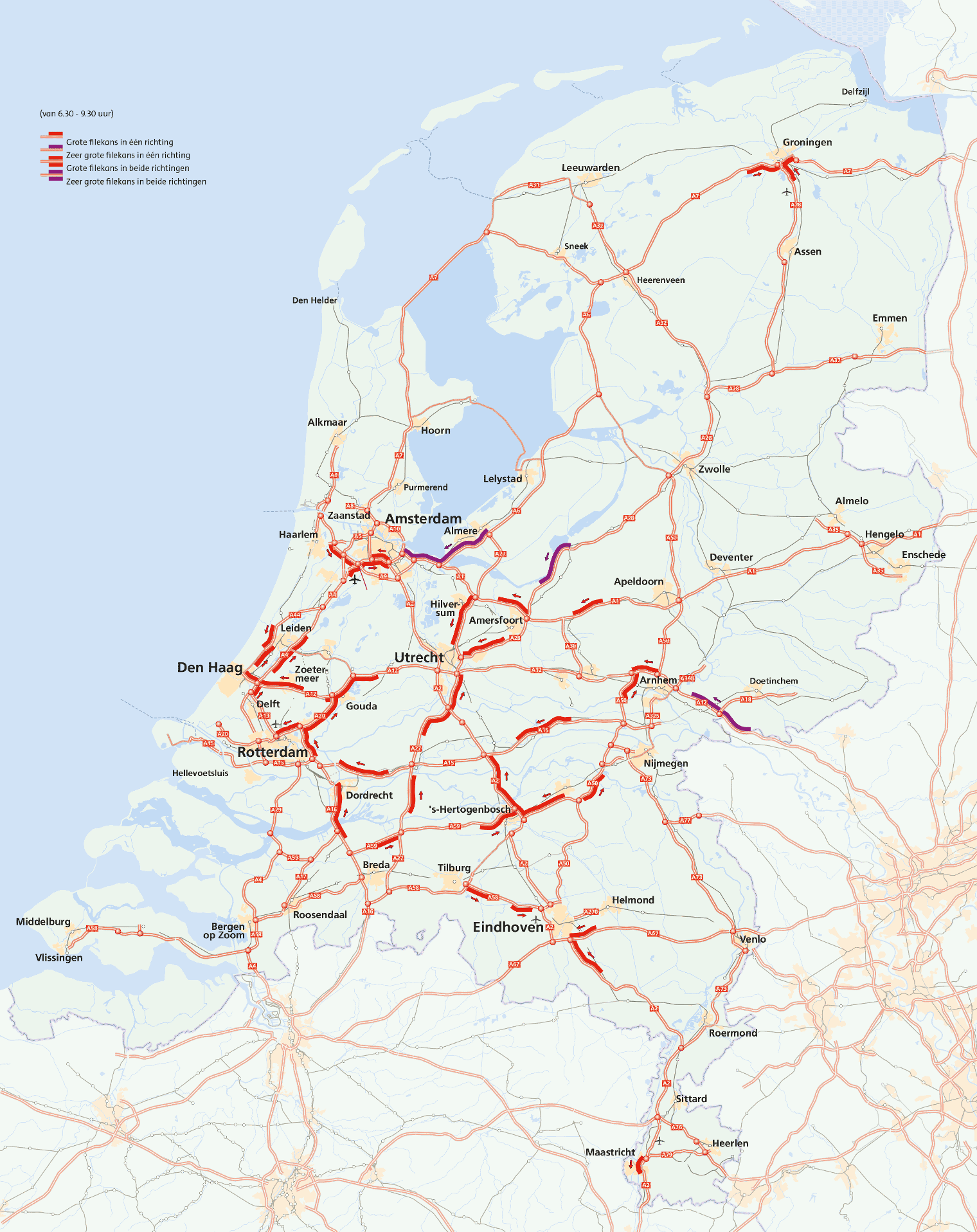 |
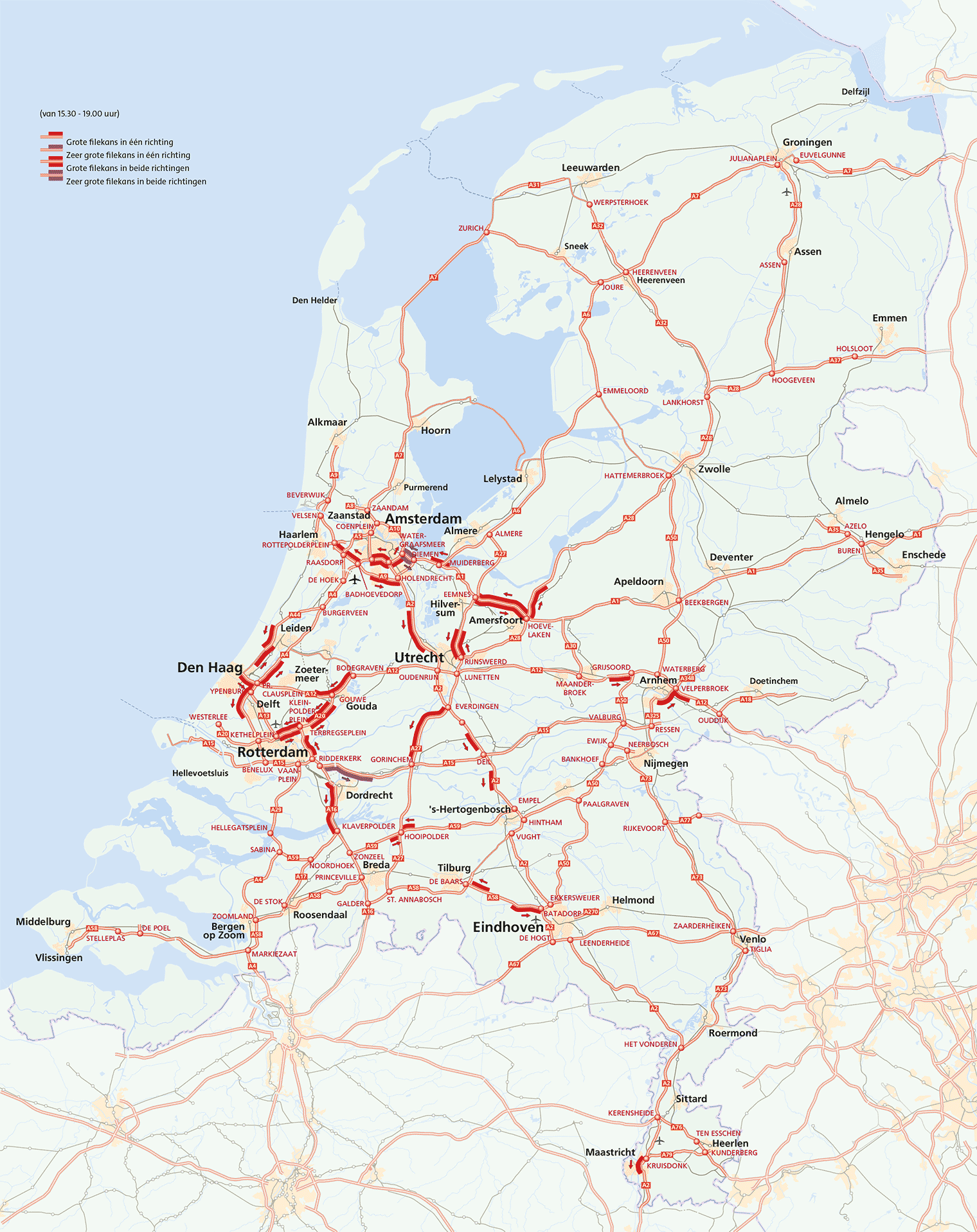 |
From these maps it can be easily concluded that Zwolle is the least busiest traffic city. For the busiest cities it is a little bit harder to point out the busiest city but it looks like Rotterdam is the busiest when morning and evening rush hour are both taken into consideration. From Rotterdam a circle of approximately 48 can be drawn and from that a location can be chosen where the parcel delivery truck has to deliver. From the traffic rush hour maps it seems that in the direction of Utrecht the most traffic jams takes place. Selecting a location in that direction will lead to the extreme where the delivery truck needs the most time.
Before proceeding the analysis, a few important notices should be made. The first notice is that the delivery centers are placed very concentrated in area's where a lot of traffic jams take place. This is a very strategically way to deal with the demands in very population dense area's. A second notice is that Bol.com and PostNL will not give information about the division of parcel delivery's per distribution center so an educated guess should be made determining which distribution center delivers where. The third notice is that because the distribution centers are placed in the strategic way it is done now, analyzing an extreme where the truck has to delivery a package exactly 48 km in the direction of a high potential traffic jam is not possible. The reason for this is that the location from a distribution center can be done by an other distribution center. So choosing Rotterdam as leaving point for a delivery in the direction of the Randstad will probably will not be the best choice for analysation. Hence another reasoning for a different city should be made. And a fourth notice is that Google maps doesn't include the average of traffic jams but instead takes the current traffic jam situation. Therefore two options can be taken; one is just taking "snapshot" of the travel distance Google maps gives or two, take a constant delay time that is incorporated in the travel time to a location. This delay time can be modeled by setting the average time over the whole travel distance to a constant. This time constant can be approximated by taking in account the average speed a truck drives in cities, suburbs, the country, village streets and the highways. It can be stated that on the types: city, suburbs, country and village streets the average speed a truck drives is 50 km/h which keeps in mind that these types are built-up area. For the highways the maximum speed of 130 km/h can be used but during traffic jams then it comes down to 50km/h.[3] It depends highly on the distance on what the average speed should be since if the road contains mostly high ways the average would be higher than a road that goes through the city most of the time.
The best choice for getting a result where the an extreme can be derived is when the distribution center in Nieuwegein delivers a parcel to a location near Almere. The reason for this is as follow: If busiest city Rotterdam was chosen and the truck needed to deliver in Utrecht it will not give a reliable travel time since the delivery also could have been made by approximately 4 other distribution centers; Amsterdam, Den Haag, Nieuwegein and even Den Bosch. Its seems assumable that a parcel delivery suffers the most from traffic jams if the delivery location is in the north east direction with respect to Amsterdam, Den Haag, Rotterdam and nieuwegein together. The reason for north east is because towards the south the traffic jams are less long and concentrated or it is unclear which distribution center should do the delivery. Therefore it seems reasonable to disregard Rotterdam and Den haag as potential example for a worst case delivery scenario and thus Amsterdam and Nieuwegein Remain.
In the maps below circle are drawn that are exactly 48 km To select a delivery location that is exactly 48km crow flies is hard so we approximate by selecting a street that is near the edge of the 48 km circle. From this map it seems more reasonable that PostNL chooses Nieuwegein as distribution center that needs to deliver at Almere since the road seems more as the crow flies and Amsterdam is at its own a very busy city where the traffic is horrible so if the distribution center of Amsterdam needs to deliver to a location near Almere it will probably be very ineffective.

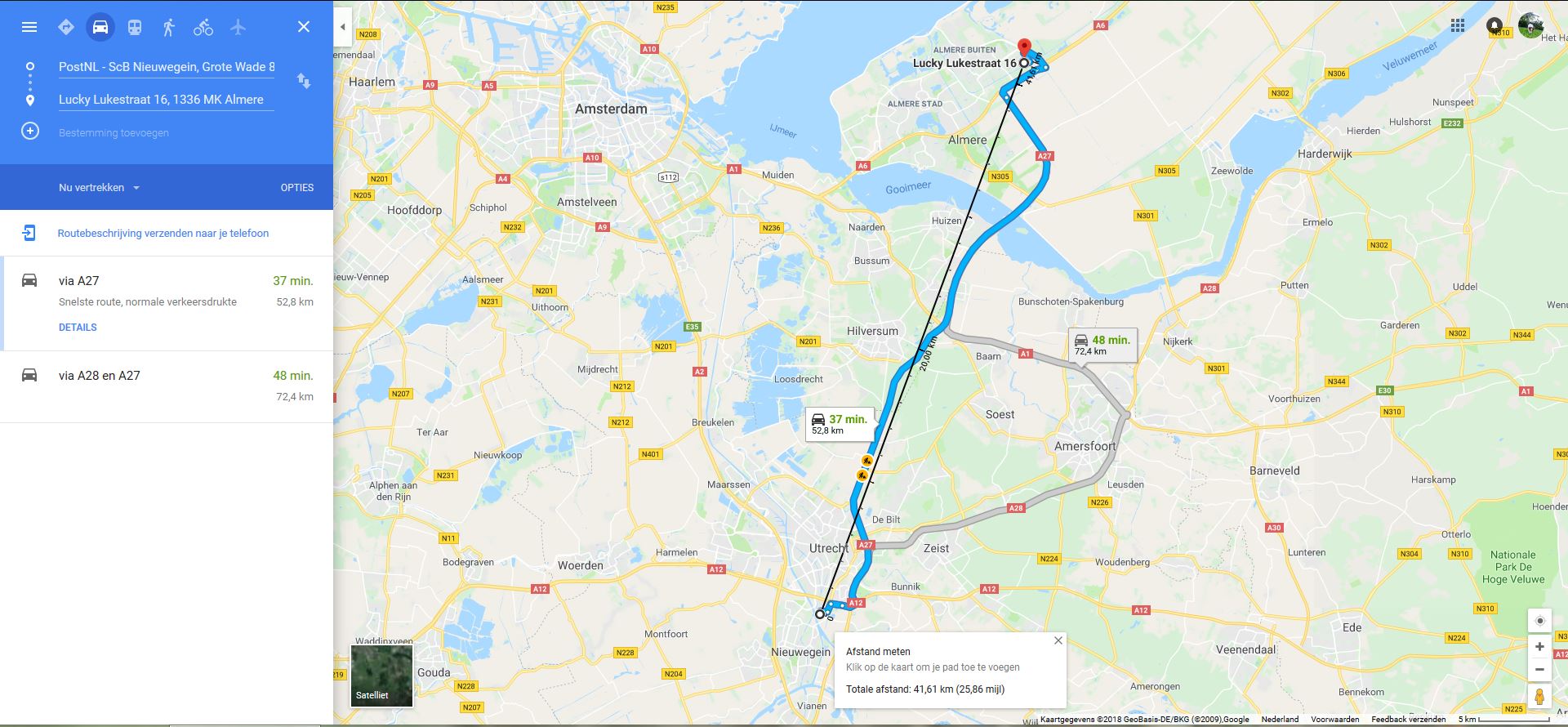 |
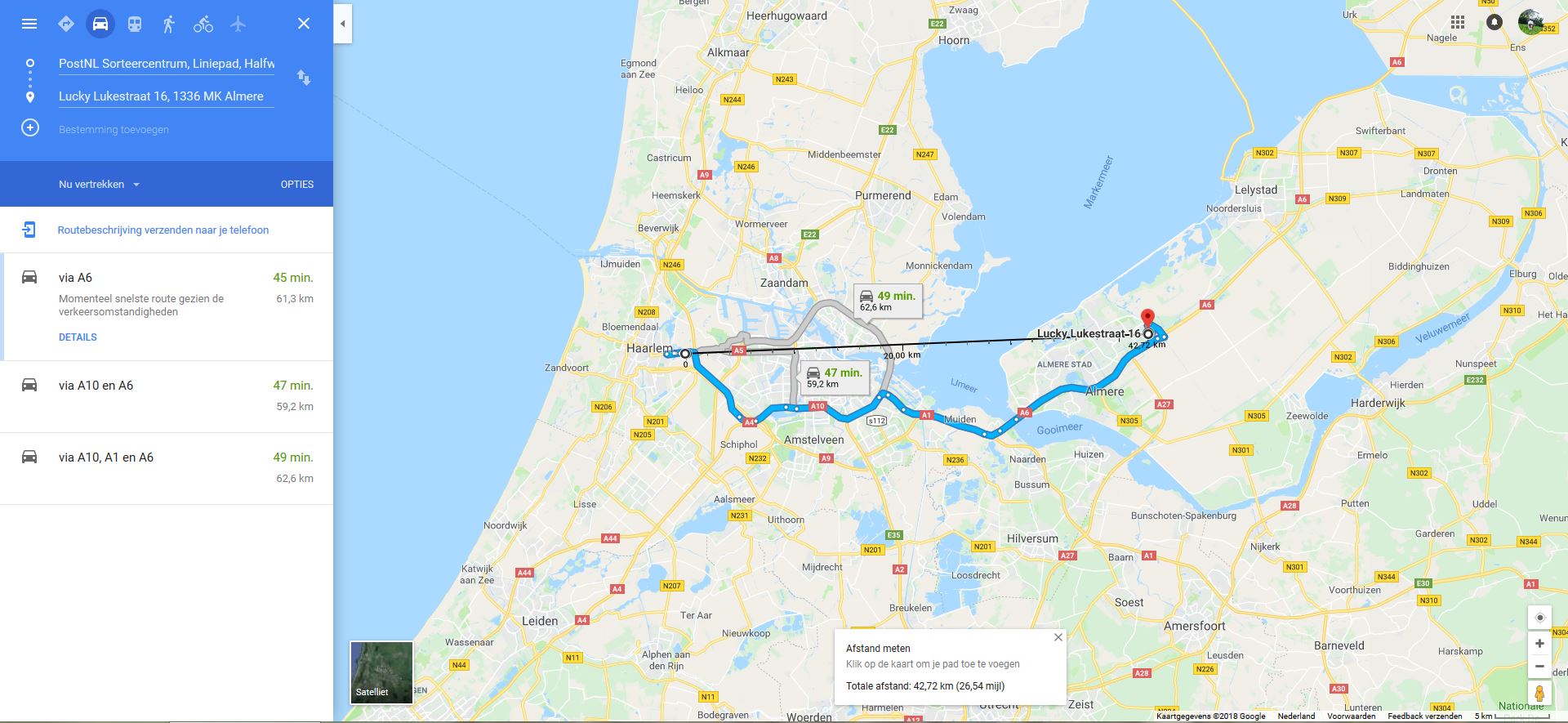 |
Comparing a drone with a truck in Google maps is shown in the two images above. The left one shows the substantiated case where the truck leaves from Nieuwegein and the right one is to show the disadvantage of letting the truck leave from Amsterdam where not only the road is meandering but it also have to go through the busy streets of Amsterdam, And it is also approximately 10km longer in terms of the travel road but also 1 km longer in a straight line. So in that case it can be concluded that the extreme we chose to compare is suitable. The pictures are taken during non rush hours so to incorporate the traffic jams the average is taken of the travel time calculated by Google Maps and the travel time if the whole road was driven with a speed of 50 km/h. With that the following data is received.
| Truck | Drone | |
|---|---|---|
| Travel Time (min) | 50.18 | 31.2 |
The beehive
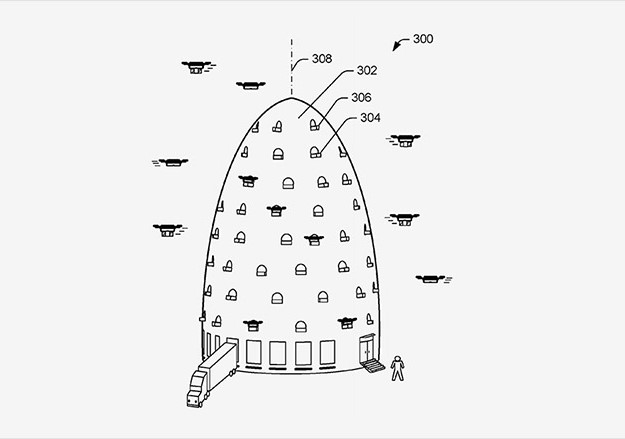
To be able to deploy delivery drones from distribution centres and warehouses, one must come with a smart design so drone deployment and truck deliveries don’t interfere. Today’s distribution centres and warehouses are typically large-volume single-floor buildings, located at the outer parts of the mayor cities [4]. But since drones are not restricted to the ground floor, it could efficiently fly from higher levels. Combining this possibility with the distribution centres results in the beehive.
The beehive is a distribution centre for the delivery drones to take off and land. [5] The beehive facilities would be built vertically so truck deliveries can be deployed from the ground floor while the drones can be deployed from higher levels. In this way the drones are already at a higher level in the sky and therefor restrict the danger of contact with pedestrians. [6] Inside the beehive robots move goods around and conduct maintenance on the drones. And since the facilities are so high, the delivery drones could fly inside as well. And by taking off from such a high level saves time and energy for the drones since it doesn’t need to ascend much, making it possible to fly further and faster. Another advantage of the multi-level facility is that the drone activities largely take place on the upper levels, therefor minimizing the noise for surrounding areas [7]. Since the building has multiple levels, it could have a considerably smaller footprint, therefor allowing the beehive to be build closer to city centres. Building the beehives closer to the cities results into items that may be delivered more quickly to the growing population of people that live in the cities, as well as the growing number of people who work in the cities [8].
The beehives could facilitate a large volume of drones that continually fly in and out to deliver the packages and recharge at site. Those drones could fulfil thousands of orders a day, depending on the number of drones being used. And to be able to control and oversee the flight operations of the drones the beehive could facilitate a command centre, comparable with a flight control tower at the airport. With the use of this command centre no drone delivery flies unseen or unmanned while the drones itself is autonomous.
Limitations of the drone’s flying radius
To understand the use and implementation of the beehive, it is important to look into the possibilities of the delivery drones. To be able to analyse the situation, the Amazon prima air delivery drone is used. In their current research status, these drones can cover a total distance of 32 kilometres. This means that the drones can fly within a radius of 16 km from the distribution centre on a full battery. Therefor one beehive can cover up a surface of (π * r2=) 803.84 km2. To cover up the entire Netherlands its surface (42.000 km2), this results in a demand of over 52 distribution centres. Comparing this to the current number of distribution centres of PostNL which is 6 centres through the entire Netherlands[[9]], a proposed increase of 875% on distribution centres is necessary. This would be the only way to deliver a package on the maximum distance of 16 km within 30 min. And for every delivery one drone is occupied for a maximum of 90 minutes, taking into account that recharging takes half an hour.
A possible solution for this would be to install wireless charging pads throughout the Netherlands, for example on lampposts. This would increase the distance one drone can cover with 200% since the first time the drone can fly straight for 32 km, before fully charging and then cover another 16km so it can still return to the charging pad. This would mean one distribution centre can cover up a radius of 48 km and therefor a surface of 7234 km2. This would mean that about 6 distribution centres could cover up the entire Netherlands, if ideally distributed over the country. In this case a drone maximally takes about 75 minutes for one delivery and another 75 minutes to return and another 30 min to recharge again, resulting in a total time of 180 minutes. It is a possibility to change the battery of the drone once it is back to the beehive, which can save up the last 30 min with just one action.
However, the Netherlands is not a perfect shape so the surfaces will not align with 6 beehives. Furthermore the distribution centres out optimally over the Netherlands. Currently the furthest distance to the closest distribution centre in the north is about 140 km. A clear overview of the centres of PostNL throughout the Netherlands can be seen in the figure above. The figure aside of it shows a favourable distribution of the beehives with respect to covering the most area. Currently, the centre of the Netherlands can be reached quite well with sometimes more than one distribution centre in range. The outer parts of the Netherlands are actually out of reach, even with the solution of wireless charging pads. Even when applying a second charge moment in the flight, extending the range with another 32 km, not every part of the Netherlands can be reached. And due to this extra charge the total flying time increased with 90 minutes and the delivery time is extended to 135 minutes, causing one drone to be occupied for about 5 hours before be ready for the next delivery.
It can be concluded that spreading out 6 beehives throughout the Netherlands is not going to be enough to deliver packages with drones throughout the entire Netherlands within a profitable time. A better implementation for the placements of the beehives would be to look into the population density. To see if PostNL has its distribution centres on favourable places, its warehouses are compared to the population density in the Netherlands. And around these distribution centres, the radius of the drone’s flying distance is drawn, as seen the figure below. The figure aside of it shows a favourable distribution of the beehives throughout with respect to the population density. A few notions can be made when comparing the distribution of distribution centres of PostNL compared to the distribution with respect to population density:
- Currently the distribution centres seem to mainly cover the most densely populated areas. Therefor leaving out a big part of the Netherlands.
- The map that respects the population density still doesn't cover the entire area of the Netherlands
- There shouldn't be a reason for PostNL not to place distribution centres in the northern part of the Netherlands existing of Friesland, Groningen and Drenthe.
Implementation of the beehives

To analyse the all the advantages of the beehive, it has to be analysed in a real situation. For this analysis it is chosen to compare a normal distribution centre on the outskirts of a big city to the beehive build almost in the city itself. And what better city to analyse than Amsterdam.
First of all, Amsterdam currently has a delivery of over 40.000 packages a day. And with the current grow of online purchases it is expected to grow over 100.000 packages a day within 10 years. [10] But according to the Amsterdam, the dense populated city can’t facilitate that amount of packages with the already their overcrowd traffic. Currently almost all packages are delivered with a van and a small amount is delivered with motorbikes or bicycles.
So let’s compare the possibilities with a normal distribution centre and the beehive. PostNL has its current distribution centre placed at Australiëhavenweg 100, Amsterdam. This location is indicated in the figure aside, as starting point of the route, encircled in black. Even though the Beehive could be placed quite a bit closer to the city itself, it is placed at the same location for the first comparison.
To start off, one package has to be delivered directly from the distribution centre to Agnietenkapel, located at Oudezijds Voorburgwal 231, close in the city itself. First of all, the package could be delivered with a van, having two options. First, driving through the city and taking a route of 11.2 km that takes up to 36 minutes or drive around the city taking a route of 20.3 km that takes up to 26 minutes. When delivered with motorbike it takes the route of 11.1 km and about 31 minutes. When delivered with bicycle it takes the route of 10.0 km that takes up to 35 minutes. But when delivering with a drone, it could fly in a straight line, taking a route of 7.2 km. Taken into account that it flies with an average speed of 60 km/u, it takes less than 8 minutes to deliver by drone.
Truck-drone combination
A truck-drone combination is another possible solution. The main idea of this concept is to deploy a number of drones from a stationary truck. By using a strategic position for the placement of the truck, the distance covered by the drones is minimized, hence the delivery time can be reduced. Implementing this method creates a number of difficulties that have to be tackled. First, the capacity of a truck has to be approximated. The amount of drones per truck and the amount of packets per truck have to be determined. This is done by making assumptions, this way a truck contains at least 10 packets and 2 drones. To investigate the efficiency, the calculations can be repeated for different numbers of drones and packets per truck.
Static deployment
Another important problem is that of the placement of the truck. In this delivery method it is assumed that 1 truck is placed in Eindhoven for all the deliveries at that time. To optimize this placement, different techniques can be used.[11] The two most appealing are:
1) Determine the geographic midpoint.
2) Determine the centre of minimum connecting distance (aka Steiner point).
For the first, the benefit is that the maximal distance from the truck to a destination is minimal. This way it can be prevented that an empty truck is extensively delayed by a single drone that is still enroute to/from the furthest delivery destination. This method is optimal when the number of drones is significant compared to the amount of packets to be delivered. For the second, the benefit is that the total distance travelled by the drones is minimized. Therefore when the number of drones is very small compared to the amount of packets, the total time can also be optimized.
To compare this method with a traditional parcel delivery, an example scenario is worked out.
The distribution company has 10 packets that they have to deliver in the city of Eindhoven.
The locations at which they have to deliver are (random locations) shown in Table I.
Calculating the geographic midpoint results in: 51.448193, 5.464556
Calculating the centre of minimum distance results in: 51.443398, 5.465531
The comparison between the traditional delivery system and the truck-drone is computed. Since the distribution centre closest to Eindhoven is located at De Herven in Den Bosch, this means that the vehicle will be approaching from the North. With this in mind, the shortest route for the traditional delivery can be planned, starting at Kerkdorp Acht. The travel time from the distribution centre to Kerkdorp Acht is approximately 25 mins. The delivery route followed from there on is shown in the figure on the right.

This accounts for an additional 1h 17mins for the delivery of all 10 packages. In total this results in a delivery-travel time, for the last package, of 1h 42mins.
Now this can be compared with the truck-drone method.
First of all, the truck has to drive to the geographic midpoint, this takes approximately 30 mins.
From there, the drones will be deployed.
A deployment strategy for the drones is crucial to optimally use both the resources and the time available.
By measuring the total distance from the geographic midpoint to the delivery destinations, we can compute the minimal number of drones required to deliver the 10 packets without recharging.
The distances towards each point are shown in Table I.
| Delivery destinations | |||||||||||||||||||||||||||||||||
|---|---|---|---|---|---|---|---|---|---|---|---|---|---|---|---|---|---|---|---|---|---|---|---|---|---|---|---|---|---|---|---|---|---|
|
Now with a total flight distance of 47410m it is known that a minimum of 2 drones is required to deliver all packets without recharging (assuming a total range of 32km for each drone). Table II shows the order of delivery and the (cumulative)time it takes for each delivery. It is chosen to first go for the furthest points, this way at the end of the complete delivery cycle, the latency will be as low as possible.
| Delivery destinations ordered | |||||||||||||||||||||||||||||||||||||||||||||||||||||||||||||||||||||||||||||||||||||||||||||||||||||||||||||||||||||||||||||||||||||||||||||||
|---|---|---|---|---|---|---|---|---|---|---|---|---|---|---|---|---|---|---|---|---|---|---|---|---|---|---|---|---|---|---|---|---|---|---|---|---|---|---|---|---|---|---|---|---|---|---|---|---|---|---|---|---|---|---|---|---|---|---|---|---|---|---|---|---|---|---|---|---|---|---|---|---|---|---|---|---|---|---|---|---|---|---|---|---|---|---|---|---|---|---|---|---|---|---|---|---|---|---|---|---|---|---|---|---|---|---|---|---|---|---|---|---|---|---|---|---|---|---|---|---|---|---|---|---|---|---|---|---|---|---|---|---|---|---|---|---|---|---|---|---|---|---|---|
|
So for the truck-drone combination consisting of 2 drones, the drone travel time is 1903.2s, or approximately 32 mins. For 6 drones, this time is reduced maximally to 760.16s, or 12.7 mins. With all results gathered, Table III shows the final comparison of the traditional method and the truck-drone method.
| Summary | ||||||||||||||||||||||||||||
|---|---|---|---|---|---|---|---|---|---|---|---|---|---|---|---|---|---|---|---|---|---|---|---|---|---|---|---|---|
|
It can be concluded that a lot of time can be gained by making use of this truck-drone combination. Increasing the amount of drones results in an increase in time gain, however a maximal time gain is reached at 6 drones (in this specific scenario), at this point the max travel time for the group of drones is equal to travel time of the drone that has to fly to the furthest destination.
Dynamic deployment
Even though using a static truck with multiple drones for parcel delivery offers a great gain in time efficiency compared to the traditional method, this still can be enhanced by optimizing the method. One way of doing this is, as shown in the tables above, by increasing the number of drones per truck. Another possible point of optimization is the truck placement. Instead of using a single position for the truck, a dynamic approach in which the truck is also moving while deployment is ongoing is probably even more efficient for time gain.
This dynamic approach creates a few extra difficulties. The first one is that of the deployment itself, certain questions need to be answered to verify the possibility of application. Can a drone be deployed while a truck is driving? What is the optimal route for the truck? Since the solutions to these questions are way more complex compared to the static approach, a basic solution is given that still has a lot of room for improvement.
Using the same example scenario as for the static deployment, the dynamic approach is shown and simulated delivery times are calculated. Since the truck doesn't deploy at the geomidpoint anymore, new locations for deployment should be appointed. Based on the results of the static approach, it is known that for sufficient amount of drones, the main factor that constrains the max delivery time is the max distance from the truck to the furthest destination. So the aim of the dynamic approach will be to route the truck to minimize this distance.
The example scenario has Kerkdorp Acht as the furthest distance of delivery for the drone. At the same time, this point is the closest to the distribituion centre in Den Bosch. This long distance can be eliminated or minimized by deploying the drone at the point where the truck is near the location, this point is marked by 1 in the figure to the right.
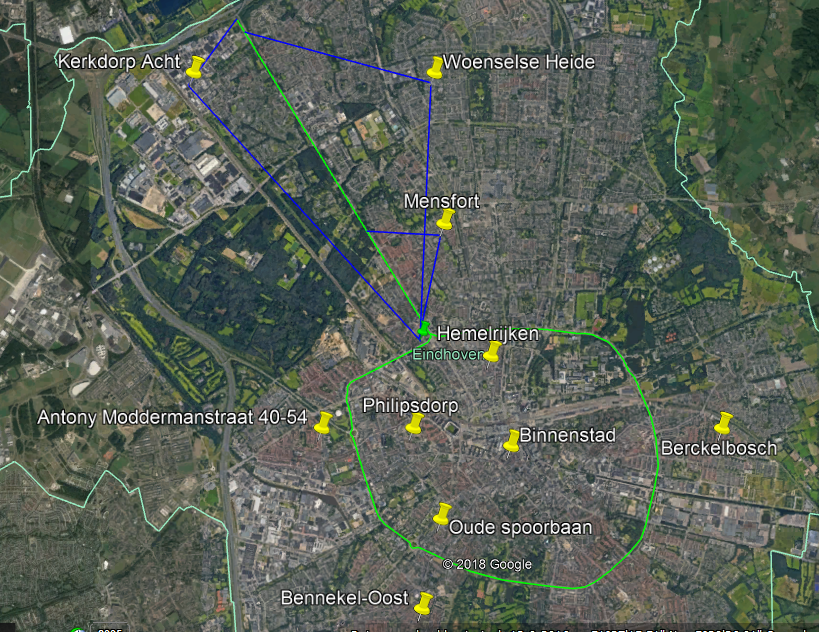 |
The main strategy is then based around a traject that passes close to most destinations (shown in figure as green line). At certain stages in this traject, drones are deployed (shown as red markers). However, the distance travelled by the drones is larger than that of the truck, therefore with the assumption that the drones have an average speed of 45km/h, certain 'holds' must be executed by the truck to retrieve the drones. These are shown in the figure as green markers. In practice this can be done by rerouting to a sideroad, where parking for a short period is allowed. Then once the drones have arrived at the truck, the main traject can be continued.
The Zeppelin warehouse
The last option which we consider as a delivery method with drones for packages is the zeppelin warehouse. For this idea Amazon has been awarded a patent. The idea of this delivery method is basically a giant flying drone mothership zeppelin warehouse, better known as the airborne fulfillment center (AFC) at high altitudes of around 45.000 feet in the air. This AFC contains lots of products and unmanned aerial vehicles (UAV/drones) which are used for the delivery of these products. The UAV will leave the AFC to deliver the product when the customer places an order. An advantage of this delivery method is the fact that the UAV’s will be able to have a much wider delivery range while consuming less power as they would be gliding down to deliver packages instead of having to take off and land. To maintain the functionality of the zeppelin warehouse there are used some smaller airships to return the UAV’s back to the AFC, to resupply the mothership with more inventory and fuel and shuttle workers to the flying factory. Another advantage is there is the possibility to deliver items within minutes. The mobile nature of the warehouses would allow Amazon greater flexibility in managing inventory in the face of changing demand. For example, the patent offers a hypothetical case of deploying a AFC near a sport stadium to allow for immediate delivery of team merchandise and snacks during a game. Also the drones would be able to communicate with each other via a mesh network to give information such as weather and route. UAVs could also recharge on the airship. For a visualization of this idea see the image below.
 |
Coaching Questions
State of the art
Questionnaire
1. Ben je een man of vrouw?
2. Hoe oud ben je? (categorieen geven)
3. Hoogst voltooide opleiding? (basisschool, MAVO,HAVO,VWO,MBO,HBO,WO, anders:..)
4. In wat voor soort omgeving woon je? (stad, dorp, platteland)
5. In welk type huis woon je? (flat, vrijstaand huis, twee onder een kap, rijtjeshuis)
6. Maak je gebruik van de mogelijkheid om online pakketten te bestellen? Zo niet, ga door naar vraag 4. Zo ja, ga door naar vraag 5.
7. Waarom maak je geen gebruik van deze dienst? (meerdere opties kunnen geven)
• de leveringssnelheid van het pakket is niet hoog genoeg
• wil het product liever in de werkelijkheid kunnen beoordelen/zien/aanraken
• niet betrouwbaar
• teveel bezorgkosten
• hinderlijk dat je thuis moet zijn op het moment van bezorgen
• hinderlijk dat je het pakket moet ophalen bij een pick up point
• de Track & Trace van het pakket is niet accuraat genoeg
• het is moeilijk en tijdrovend om een pakket te retourneren of te ruilen
• ik ben bang dat mijn persoonlijke gegevens voor andere doeleinden worden gebruikt
• het voelt als privacy schending dat mensen weten wat ik bestel
• de klantenservice is slecht
• ik kan geen specifieke vragen stellen over het product als ik dit online bestel
• het onjuiste product kan worden opgestuurd
• ik ben bang dat mijn pakket op de verkeerde locatie wordt afgeleverd
• ik vind het personeel onvriendelijk
• ik weet het niet
• anders namelijk:
8. Ben je tevreden over de huidige bezorgmethode? (helemaal niet tevreden, niet tevreden, neutraal, tevreden, heel tevreden)
9. Hoe vaak bestel je gemiddeld een pakketje op jaarbasis (meerdere opties geven)? (0-5,5-10,10-15,15-20,20-25,25-30, meer dan 30)
10. Welke dag bestel je meestal? (werkdag, zaterdag of zondag)
11. Op welk deel van de dag bestel je meestal? (ochtend (6:00-12:00), middag(12:00-18:00), avond (18:00-23:59), nacht (0:00-6:00))
12. Geef met cijfers van 0 t/m 10 aan hoe groot je irritatie is bij de volgende gevallen (van geen tot veel irritatie):
• De leveringssnelheid van het pakket is niet hoog genoeg
• Ik kan het product niet in de werkelijkheid beoordelen/zien/aanraken
• Online bestellen is voor mijn gevoel niet altijd betrouwbaar
• De bezorgkosten van de pakketten zijn te hoog
• Het voelt als privacy schending dat de medewerkers kunnen zien wat ik bestel
• De klantenservice is slecht
• Ik kan geen specifieke vragen stellen over het product als ik dit online bestel
• Het onjuiste product wordt opgestuurd
• Mijn pakket wordt op de verkeerde locatie afgeleverd
• Het personeel is onvriendelijk
• Het is moeilijk en tijdrovend om een pakket te retourneren of te ruilen
• Mijn persoonlijke gegevens zijn bij het bestellen van een pakket voor andere doeleinden worden gebruikt
• Thuis moeten zijn om een pakket te kunnen ontvangen
• Wanneer je niet thuis bent op het moment van bezorgen, moet je het pakket ophalen bij de buren of een pick up point
• Wanneer je thuis bent en het pakket geleverd wordt, is contact met de bezorger onvermijdelijk (bijvoorbeeld wanneer je in je in je pyjama zit, op de wc zit of net de douche in wilt stappen)
• Het tijdsinterval waarop mijn pakket geleverd kan worden is te groot
• De locatie van mijn pakket, die ik via Track & Trace kan volgen, is niet nauwkeurig genoeg.
13. Heb je er problemen mee wanneer je pakketten voortaan door een drone geleverd worden in plaats van door een menselijke bezorger? (ja/nee, waarom:..) (antwoord=nee -> ga naar vraag 10, dan naar 12)(antwoord=ja -> ga naar vraag 10,11,12)
14. Het bezorgen van pakketten met drones kan mogelijk veel voordelen leveren. Geef bij iedere stelling aan of dit voor jou een toegevoegde waarde zou zijn:
• Mijn pakket kan sneller worden geleverd
• Het pakket kan worden geleverd op de locatie waar ik op dat moment ben
• De bezorgkosten van het pakket kunnen verlaagd worden
• Er is meer privacy omdat de bezorger is vervangen door een drone
• Het pakket kan niet meer op de verkeerde locatie worden geleverd
• Er is geen contact met de bezorger meer omdat deze is vervangen door een drone
• Het is makkelijker en sneller om een pakket te retourneren of te ruilen
• Het tijdsstip, waarop mijn pakket wordt geleverd, kan exacter worden aangegeven
• Je kan live zien waar je pakket zich bevindt, dus de Track & Trace verbeterd
15. Stel dat het bezorgen van pakketten met drones de vaste bezorgmethode wordt, zou je dan extra geld betalen voor een menselijke bezorger?
